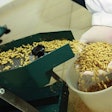Customer satisfaction is the core of Cottage Grove, WI-based Landmark Services Cooperative’s business plan. So, when the 15,000 member strong co-op’s board of directors conducted a study in 2012 to measure satisfaction with its Evansville, WI, shuttle loading facility, it knew something had to be done to improve the results.
The Evansville location serves producers across an expansive territory throughout southern Wisconsin and northern Illinois and has taken in a little more than 200 million bushels of grain since it was built in 2002. At the time of the study, the facility’s capacity was 1.9 million bushels, but because of its large service area, producers still had to contend with long lines at harvest time.
Based on study participants’ less-than-satisfactory feedback, the board commissioned an expansion at Evansville with two clearly stated objectives: more speed and space.
However, Fred Johnson, Landmark Services Cooperative grain division operations manager, said that as important as it was to add speed and space, it could not be paid at the price of halting operations — even if temporarily.
Uninterrupted workflow
As the only shuttle-loading grain facility at Landmark (another is scheduled to open in Fall River, WI, this fall), it was essential that operations on-site remained uninterrupted throughout the construction of the expansion.
“[Evansville] is our key hub for the whole grain system,” said Johnson. “It’s our highest volume location, which factored into our design selection. We were looking at other designs, but several weren’t going to work because we couldn’t afford to be shut down for months to rebuild.”
With that in mind, the co-op focused on improving existing equipment — like upgrading from urethane to ceramic liners in all conveying equipment — and adding new features alongside them.
Construction began last spring, and by the fall of 2013, the facility had added a 730,000-bushel dry storage bin, a new 20,000-bushel/hour truck receiving pit, and a 7,000-bushel/hour grain dryer, bringing total storage capacity up to 2.63 million bushels.
According to Matt Severence, Landmark Services Cooperative rail superintendent, the facility encountered only a few hours of construction related downtime during the 2013 harvest.
Producers were pleased not only with the ability to use the elevator during construction, but they also enjoyed the facility’s new equipment and features, including the state-of-the-art grain dryer.
Predictive drying
Severence says the increased drying capacity significantly reduced wait times last harvest. It takes less than seven minutes to empty a truck from the time a farmer pulls onto the scales.
The 7,000-bushel/hour dryer operates automatically using temperature and moisture sensors on the top and bottom that read the wet corn coming in and the outgoing dry corn to determine when and how long to run the dryer.
Johnson described it as a “preactive” vs. reactive operation. “It anticipates the corn coming into it instead of reacting to what’s coming
out of it.”
Severence adds, “We enter a set point and it adjusts itself — slowing down to dry wetter corn or speeding up to push dryer corn through faster — until it reaches that set point. We can dry anything,including soybeans and wheat, but I’ve been using it for about a month with corn and we’ve been very satisfied with it.”
The dryer boasts Web-based controls, so Severence and Johnson can monitor the dryer anywhere they have access to the Internet, including from a smartphone.
In addition to keeping lines running smoothly on the truck side, the Web controls offer huge labor savings, according to Johnson.
“If Matt is loading a 100-car bean train, and he’s able to check his dryer with his smartphone rather than hire someone to stand there and watch it, he’s adding value by multitasking the two jobs at once.”
Storage enhancement
After boosting its dry storage capacity by 730,000 bushels, it only made sense for Landmark to invest in added quality controls inside the bin. Before the expansion, facility operators would pull samples from their bins to get moisture and temperature readings, but with the addition of temperature cables, they can pull temperature data in real time without sampling.
The cables integrate with an Excel-based program that can chart historical movements in temperature and provide reports to help make quality control decisions.
“It’s helpful to see what’s going on inside the bin temperaturewise,” says Severence. “To be able to watch the temperature rise and fall depending on the air you put on it will help us with aeration and to use our fans more efficiently.”
Growth continues
With added drying and storage capacity, the new Evansville facility is serving customers more quickly and efficiently, and it’s a model that Landmark hopes to emulate throughout its grain network.
“‘Speed and Space’ is the name of our business plan that our board of directors came up with a few years ago,” says Johnson. “It involves a long-term plan for expansions and remodels that centers on serving our customers better.”
A new Landmark facility is currently under construction in Fall River, WI, to help serve customers in the north with a location closer
to their back door.
“The Fall River facility will really complement our truck houses to the north,” says Johnson. “We transfer a lot of grain in that region, and we’ll be more efficient by cutting the transit time in half and having the ability to move more products in a shorter amount of time.”
Predictably, Johnson forecast the outcome of Landmark’s new facility on the horizon.
“Our goal is always to exceed our customers’ expectations.”
If customer feedback from the Evansville expansion is any indication, Landmark’s northern customers have something impressive to look forward to.



















